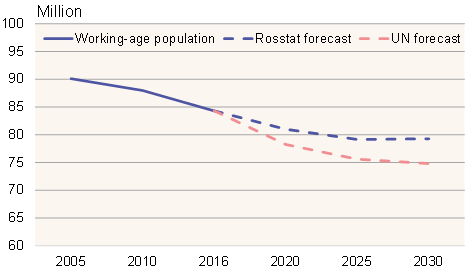BOFIT Weekly Review 13/2016
Russia’s working-age population continues to decline despite immigration
Rosstat estimates that Russia’s population at the start of 2016 was 146.5 million people. This includes the addition of the 2.3 million residents of Crimea that Russia annexed in spring 2014. Rosstat estimates that the Russian population (not including Crimea) has recorded a meagre, on average 0.2 % growth past years.
Most population growth comes from migration from other CIS countries to Russia. Net immigration, however, has been falling and e.g. last year the net flow of Uzbek migrants was negative, unlike in previous years. The recorded annual migrant flows to and from Russia have averaged several hundred thousand people in recent years, but estimates of unrecorded flows are significantly larger.
Russia’s working-age population has shrunk for nearly a decade and will continue to do so in coming years. Under Rosstat’s basic forecast scenario, the working-age population should decrease on average 0.5 % a year. The UN projections for 2016–2030 see a contraction of 0.9 % a year. A shrinking working-age population limits the possibilities for economic growth and weakens the dependency ratio.
The ratio of pension-aged Russians to the general population is increasing. Life expectancy has risen to 77 years for women and 66 years for men, although the life expectancy of a Russian man is still fairly low (e.g. the life expectancy of a Chinese man, who is much poorer on average than his Russian counterpart, is considerably higher). An aging population means higher pension costs. Russia’s pension system is in dire need of reform; its financing is already problematic.
After a sharp drop in the 1990s, Russia’s birth rate has recovered. In recent years, it has just exceeded the mortality rate. With a birth rate of 1.8, Russia is now in the same class as other countries with similar levels of GDP per capita.
About three-quarters of Russia’s population live west of the Urals. That share has increased slightly in recent years due to internal migration to large city surroundings and birth rates of southern regions above the national average.
Russia’s working-age population

Sources: Rosstat, UN.